My Moroccan odyssey
- Andrea

- Nov 18, 2024
- 26 min read
Updated: Nov 29

A little bit of background📝
This post recounts my incredible journey through Morocco in 2007. I documented my Moroccan trip in 2020 (on an earlier now-defunct version of this blog), 13 years after travelling there. The trip came about through pure chance, from a morning walk conversation with my friend and neighbour (whom I will refer to as B in my posts). B was planning a girls' weekend in Dubai with a friend who was stopping over there on her way back to Perth from Manchester. This conversation morphed into an invitation for me to join the weekend in Dubai to B and me travelling to Morocco before meeting her friend in Dubai. Our initial idea grew partly because I needed to justify the expense of the trip - B could do it cheaply as she worked for Qantas at the time - and B's long-held desire to see Casablanca. It was a crazy idea at the time for my normally cautious self, but I threw that caution to the wind and went for it!
💭I've summed up my experience of Morocco at the end of this post and have reflected on my most vivid and lasting impressions of the country and why it still means so much to me. |
Touring Morocco 🚌
B and I chose to do a tour rather than make our way around Morocco on our own. I'm not a long tour person, having spent three weeks stuck with a bunch of people on a tour bus in Europe in 1996, something that I struggled with despite the positives. My introversion and social anxiety kicks in big time when around groups of people for extended periods. However, B and I felt it was the best way to see as much of Morocco as possible in a short time. I was excited to visit a country so different to Australia and from the other countries I had been to at that point, even if on a tour bus.
We chose the 10-day Highlights of Morocco tour with Cosmos. We managed to time the end of the tour to fit with B's friend's stopover in Dubai so that we would all arrive in Dubai on the same day. The map below shows our journey.
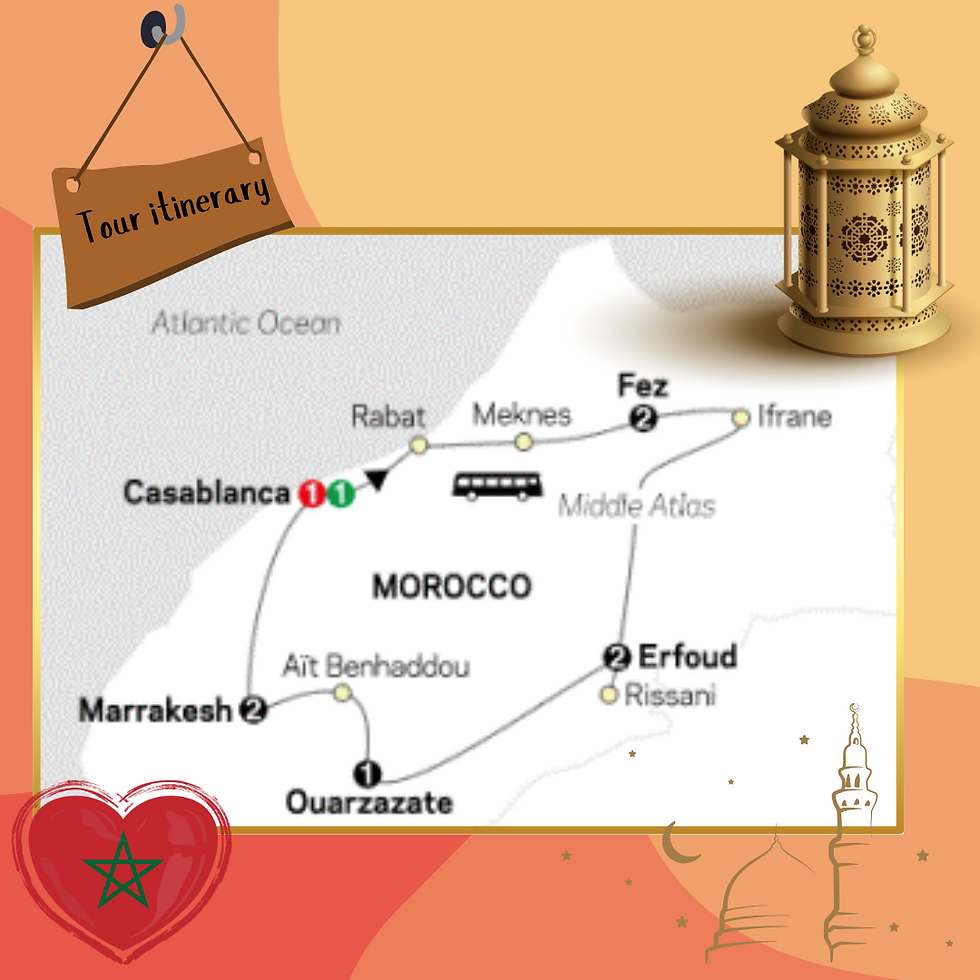
The tour started in Casablanca, where we stayed the first night and met the guide and our fellow travellers. Leaving Casablanca and its exploration for the end of the tour, we then visited Rabat, Morocco's capital, and the walled city of Meknes, before staying two nights in Fez. Our journey continued through the Atlas Mountains via Ifrane, with two nights in Erfoud, on the edge of the Sahara desert. We were lucky enough to watch the sunset sitting over the desert sand dunes before driving on to Ouarzazate, Morocco's film epicentre. Our visit to the city included experiencing the majestic Ait Benhaddou ksar (a very famous set of fortified buildings in Morocco, seen in the film, Gladiator). We descended the mountains by way of the Todra Gorge to spend two nights in Marrakech before returning to Casablanca. Awesome!
Travelling to Morocco✈️
Getting to Morocco was an adventure in itself. First of all, it's a LONG way from Australia. We flew with Emirates via Dubai, which also included a brief fuel stop in Singapore. So...it's around eight hours from Brisbane to Singapore, the same time again from Singapore to Dubai, and then another 9 hours to Casablanca. OMG.

Our Emirates flight was delayed leaving Brisbane due to a technical difficulty (can't for the life of me remember what is was now) so we had to return home from the airport and fly out the next day. Talk about an anti-climax. Both families traipsed out to the airport in the evening and then had to go back home again and return early the next morning.
The delay meant we missed our planned extra night in Casablanca prior to the tour commencing. I was disappointed about that but still glad we would arrive in Morocco to start the tour. I was worried we'd miss the start of the tour! The other worry is travelling with someone using staff travel. It's cheap for the staff member, but a tricky business, as you don't know if they will be bumped off a flight because of lack of available seats. Not to worry, we braved the stops in Singapore and Dubai on the way over and B was able to board the flight at each stage.
This was my first experience of the international airport in Dubai and back then it wasn't as big as it is now. That said, it was still enormous.

The airport is sensory overload. It's completely mad, with so many people and so many sparkly shops. I bought a 'magic carpet' mouse pad in one of the Arabic kitsch shops that I still have on my desk to this day.

Initial impressions of Morocco 💭
Entering the country was a little daunting but we made it through the border check at the airport and found our tour minivan driver. I still recall to this day my attempts to take everything in as the minivan sped to the hotel. I was acutely aware that I was in a country unlike anything I had experience before. The landscape was not dissimilar to where I live in Australia, but my initial impressions were of a place much more bustling and chaotic than home, with lots of while buildings.
Our driver took us to the hotel in Casablanca where the tour started and ended. It was late afternoon by then and we only had a little time to adjust before we had to be in the hotel bar for the meet and greet. As mentioned above, a technical fault with our Emirates plane in Brisbane created a long delay and we had lost the additional day and night in Casablanca that we had planned for originally. Adding to that stress is the experience of travelling with someone on staff travel who could be bumped off any one of the three legs if no spare seats were available. I was just glad we had made it!

I wasn't sure what to expect at the hotel, but our room was basic but rather lovely, even if we did have to share a bed. We had a short time to freshen up then decided to go for a walk to see a little bit of the city and get some dinner. We were to meet the tour group in the hotel dining room later that evening.

We had a delicious pizza for dinner (not very Moroccan!) and it was cheap as chips. Going out for dinner was our first experience of men staring at us and we noticed that the ratio of men to women in the restaurant and on the streets favoured men.
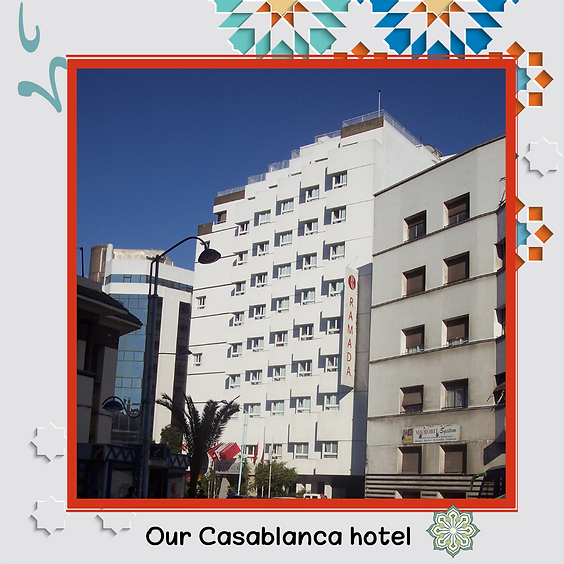
Meeting the tour group after dinner was interesting. A lot of the group seemed unlikely travellers to a place like Morocco. Sadly, it turned out that some of them did not enjoy the experience (and complained CONSTANTLY). It was disheartening to hear their constant criticisms of everything and witness their reluctance to embrace all that is Morocco. Sure, Morocco wasn't as comfortable as home, but that's the idea of exploring the world and learning about how other people live. That said, I am not sure how I avoided getting sick from all the unrefrigerated yoghurt I ate! We did make friends with two other Australian groups, two lovely nurses from Chicago, a hilarious British couple, and a couple from New York. They made being on a tour fun and interesting. Here's a picture of our group. It was taken at the end of the tour in Marrakech.

Our tour guide, Graham, made it all worthwhile. Below is a picture of him from the tour website. As I write this, Graham is still the guide for this tour. He is Welsh, and a former school teacher who arrived in Morocco in 2003 to teach in an international school in Marrakech before giving up that life to be a tour guide. Graham is not your bog standard guide - he lives and breathes the country and has made it his own, even adopting an Arabic name, Aziz. Graham told us that he found Morocco to be a refuge of sorts where he feels comfortable with his sexuality. A natural teacher and storyteller, Graham would spend the long stints on the bus telling us stories about life in Morocco. These were fascinating stories, where he used his experiences to teach us about the country, all told of course with typical Welsh charm and wit. He clearly has special relationships with the people who ran the hotels and restaurants he took us to, as when we arrived, they greeted him like an old friend. Graham is a huge part of why I loved this trip so much. He made us all fall in love with country as he has done.
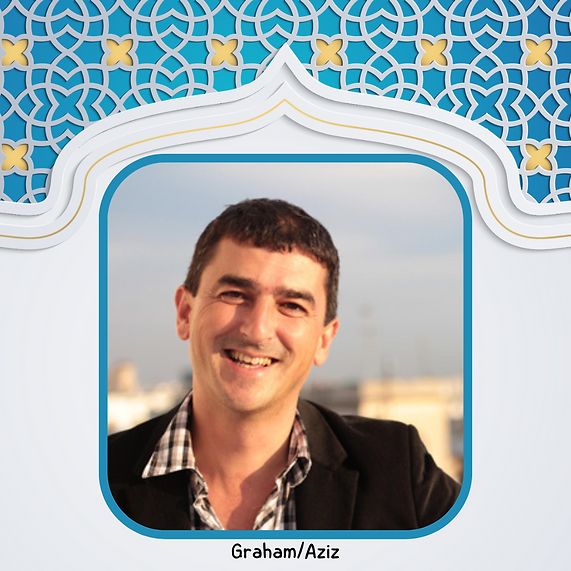
Recollections of our Moroccan tour🌍
Part 1: The beauty and contrasts of Rabat🩵
We left Casablanca early on day 1, after having arrived in the city late on the previous day. The tour officially began the night before, but it was a fairly brief meeting with Graham and our fellow travellers.
We firstly took a short ride along the coast from Casablanca to Rabat, the country's capital city. Rabat is Morocco's seventh largest city, located on the Atlantic Ocean. It was founded in the 12th century and became the country's administrative centre in 1912 when the French established a protectorate over the country. Morocco achieved independence and Rabat became its capital in 1955. This is a shot of the main street.
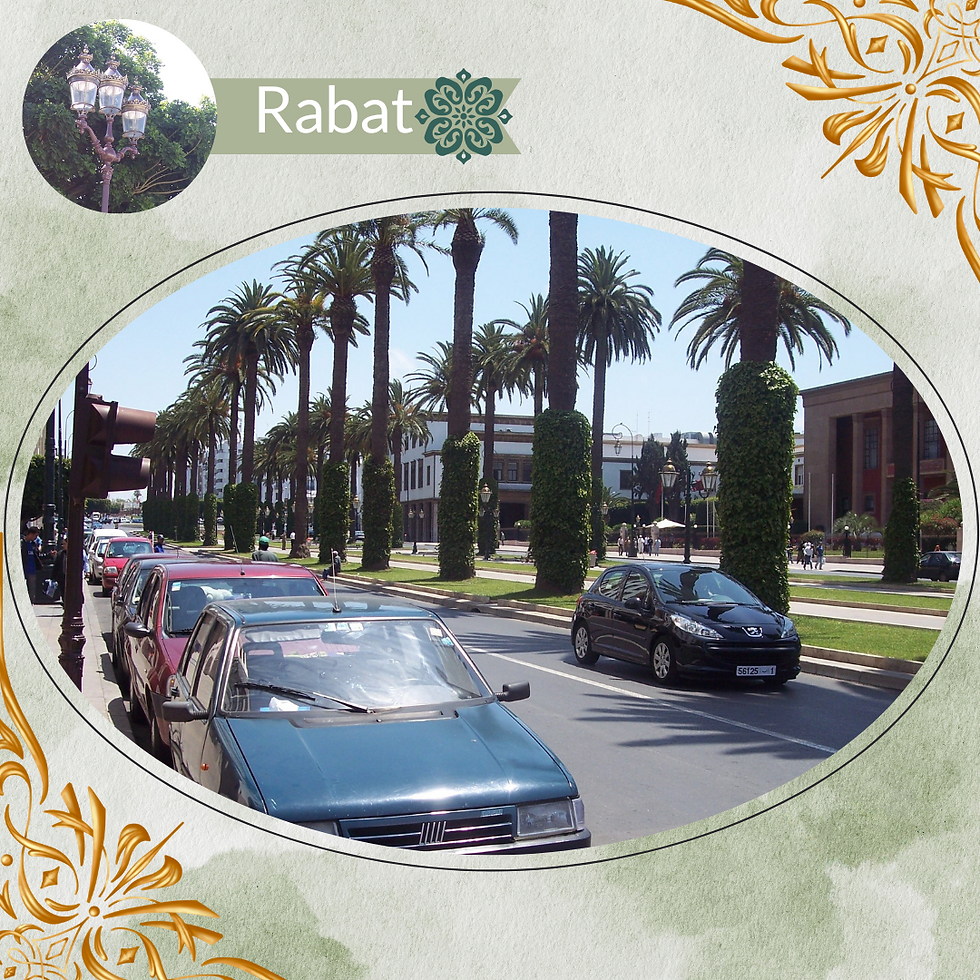
We spent the morning in Rabat and had our first taste of tagine for lunch before heading to our next stop at Meknes. I grew to love Moroccan cuisine and tagine style cooking. That stuff is delicious! We ate tagine food at most meals. Usually, we'd be asked to choose a flavour and/or a protein, the the meal would come out as a big tagine to share, or a small one for a single serve. Moroccan flavours are subtle but warm enough for you to know you've eaten something substantial.
We visited three key sites in Rabat that morning: the Royal Palace, Hassan Tower, and the Udayas kasbah.
The Royal Palace, or Dar al-Makhzen, is the primary and official residence of the King of Morocco in Rabat. The current building was built in 1864 by Mohammed IV to replace an older palace. It became the official residence of the king in 1912 after Morocco came under French control, as it is located near the what was the French administrative centre at the time. The current king chose to keep Dar al-Makhzen as the main monarchical palace after independence was achieved in 1955, and today it is the seat of government.
We didn't have the chance to see inside, but the exterior was magnificent enough, particularly as this was my first experience of Arabic architecture. How cool are those arches?

After the palace, we stopped at Hassan Tower, the minaret of an incomplete mosque, dating back to 1195. When the person who commissioned the site died in 1199, construction just stopped, and it's been left that way ever since. The architecture is a combination of Berber and Moroccan styles. The Tower was added to the UNESCO World Heritage Status list in 2012.
It was a beautiful day when we visited Rabat, and the Atlantic Ocean that you can see in the distance in the below shots was just stunning. I remember standing there, scarcely believing I was in Morocco and drinking in the beautiful architecture and the deep blue of the ocean.
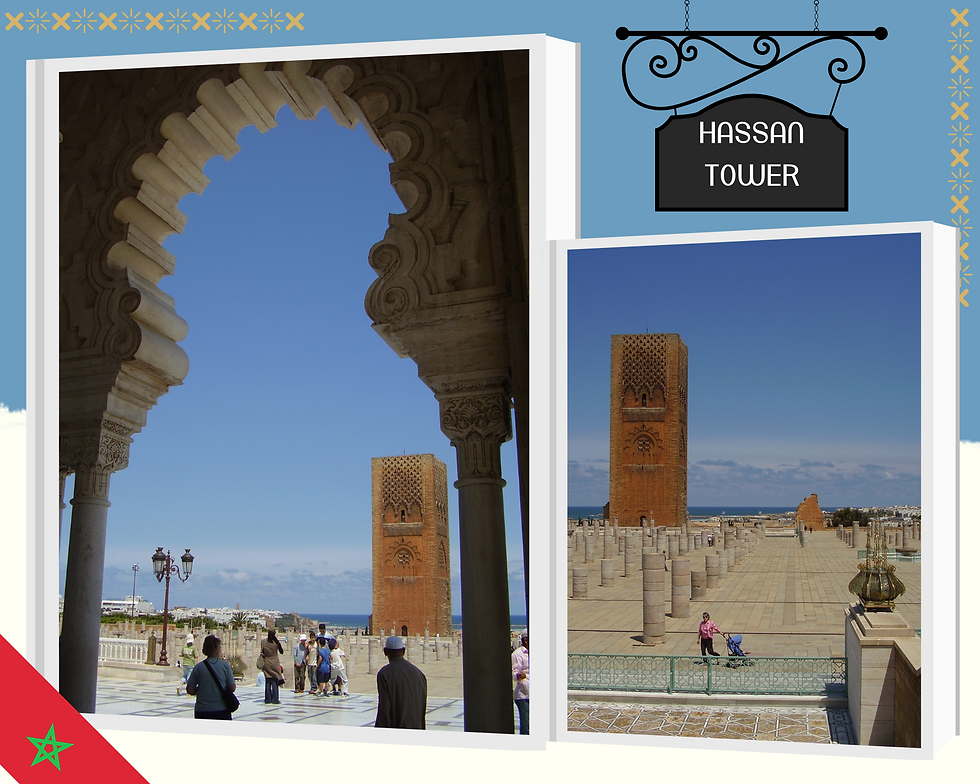
Across from the Tower is the Mausoleum of Mohammad V. The mausoleum contains the tombs of King Mohammad V and his two sons, King Hassan II (who died in 1999) and Prince Abdallah (who died in 1983). Construction began in 1961 when King Mohammad V died, and was completed in 1971.

The mausoleum stands on an elevated platform and was constructed from reinforced concrete covered with white marble. Porticos of Moorish arches characterise the exterior, with the wall surfaces above them carved with a Moorish sebka decorative motif. The mausoleum chamber is covered by a wooden mahogany dome with coloured glass, and the walls have zellij tiling. This type of tilework is made from individually chiselled tile pieces in different colours and fitted together in Islamic geometric motif patterns. The cenotaph of Mohammed V is carved in white onyx. Moroccan tilework something to see. This was my first close experience with the intricate beauty of traditional mosaics.

Our third stop in Rabat was the Udayas kasbah, commissioned by the same guy who built Hassan Tower, and now another UNESCO World Heritage site. I think the original part of the kasbah was built in the 12 century with additions right up to the 18th century. The below top left hand photo shows the kasbah's outer walls. The bottom left hand photo is the door through which we entered the kasbah.

A kasbah in Morocco is usually known by its multiple buildings in a keep or citadel, often behind a defensive wall. The most notable feature of the Udayas kasbah is its blue and white buildings. I wish we'd had more time to wander around. I just loved the narrow streets and beautiful blue and white buildings. It felt like we were on a Greek island! It was in the Rabat kasbah that my love affair with interesting doors began. How cool is the one in the below middle shot?

After lunch we visited the ruins of Chellah, just outside of Rabat, another UNESCO World Heritage site in Rabat (since 2012). The ruins are part of a fortified Muslim necropolis (a large cemetery with tomb monuments) that later became the site of an ancient Roman colony.

My favourite part of Chellah was the stork nests, often high up in the ruins. You can see the storks in the below left hand shot and in the bottom circle inset.

Our final stop before hitting Fez for the evening was Meknes, one of the four Moroccan imperial cities and the sixth largest city by population. The city was founded in the 11th century and was the capital of Morocco during the rule of Sultan Moulay Ismail (1672-1727). Its architecture is Spanish-Moorish. The city is located in a strategic position in the heart of Morocco. You can see below Bab El-Mansour, the magnificent gate in Meknes, completed in 1732.
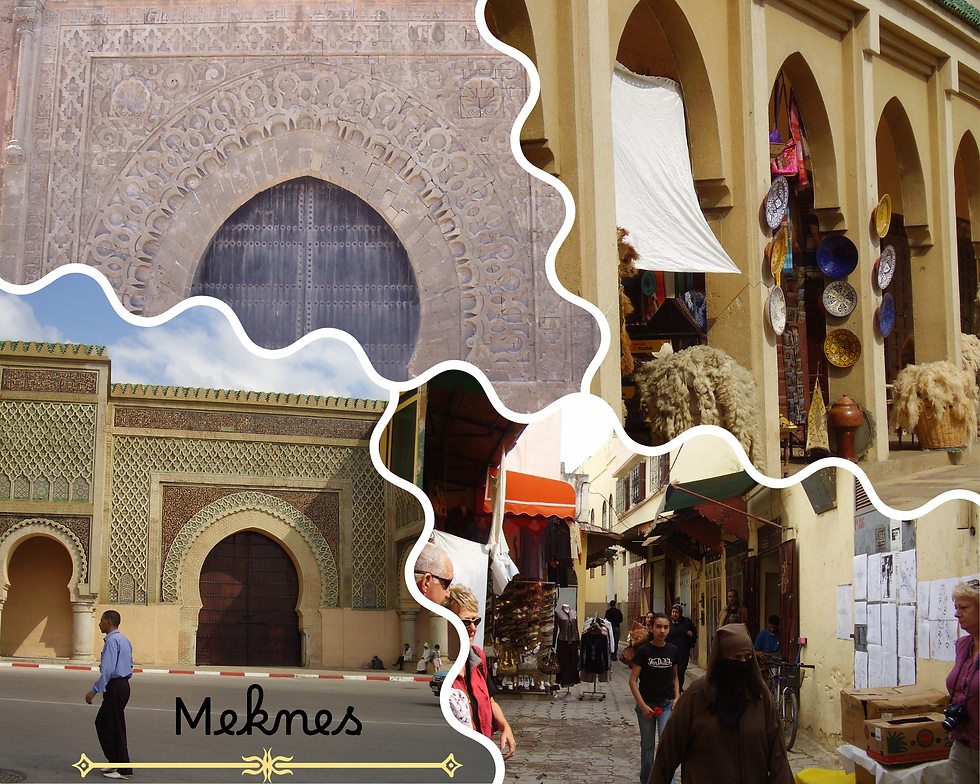
We were treated to more magnificent mosaics on our visit to the Mausoleum of Moulay Ismail. built in 1703. My photos do not do justice to the beauty of the mosaics. The intricate patterns and incredibly detailed artistry are a sight to behold.
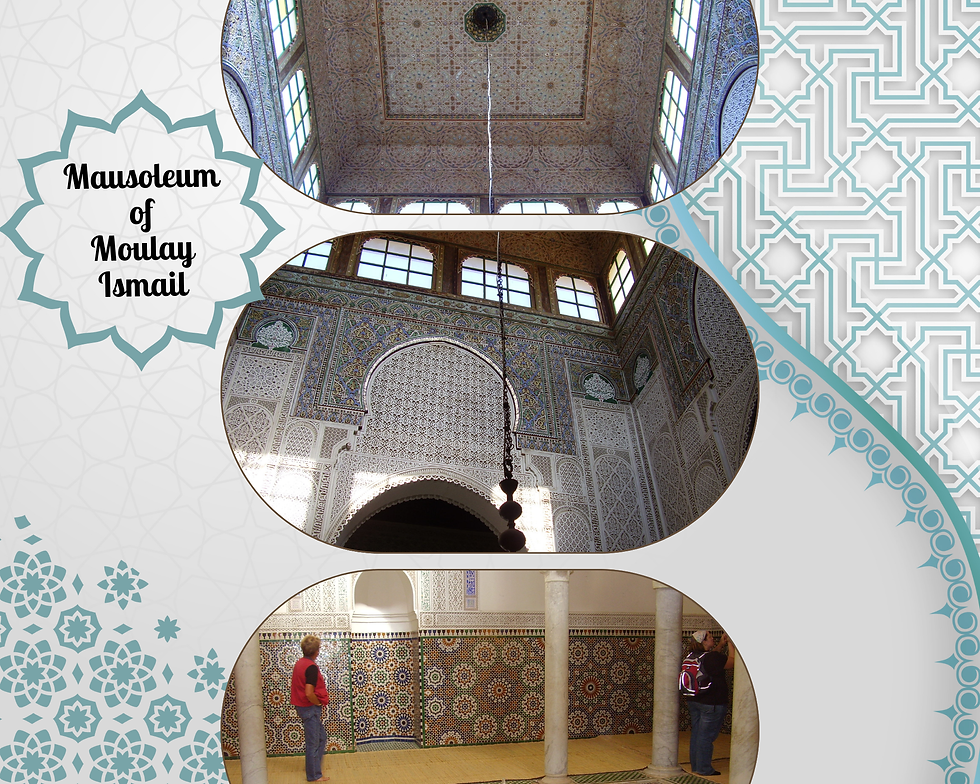
We also went to the Heri es-Swani complex, comprised of grain silos and Dar al-Ma (House of the Ten Norias), providing grain and water supplies to the Imperial Kasbah during Moulay Ismail's reign. Da al-Ma (the top right hand photo) has a large central chamber surrounded by smaller rooms surrounded by a vaulted corridor that once gave access to 15 domed chambers. These domed chambers each held a mechanical hydraulic system (a noria) which drew water from a deep well via a series of buckets chained together and raised by a horse-drawn wheel. This operation provided water to the royal city through a system of clay channels.
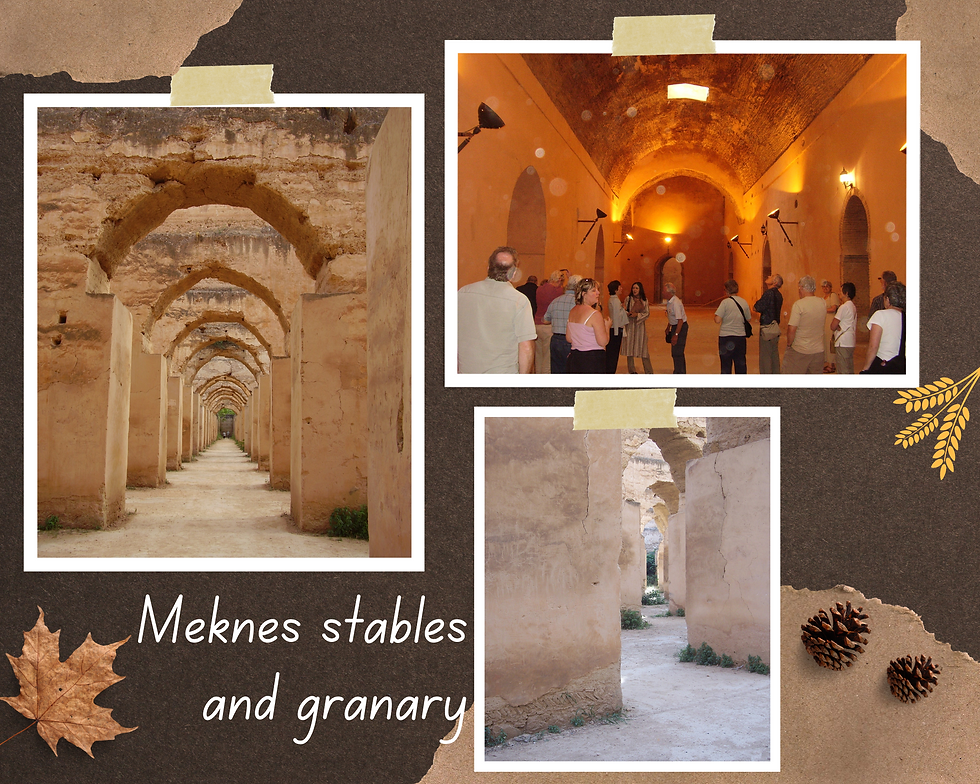
It was a long and busy first day and I fell asleep on the bus as we approached Fez in the early evening. Darn, I missed our entry into the city!
Our Fez hotel was home for two nights. It had a stunning lobby and pool as the below photos show. I loved the traditional feel of the hotel, but there were are few basic amenities missing. There was no fridge in the room to keep water cold. The shower nozzle wasn't attached to the wall so you had to hold it and wash yourself at the same time. Just a few minor inconveniences that characterised most of our accommodation, but all part of the adventure! (No complaints from me, as I was simply grateful to have the chance to experience Morocco.)

Part 2: The ancient city of Fez🤎
Day 2 of our tour was spent exploring Fez, the second largest city in Morocco after Casablanca, located northeast of the Atlas Mountains. Fez was founded during the 8th and 9th centuries and has the oldest, continuously functioning university in the world (founded in 859).
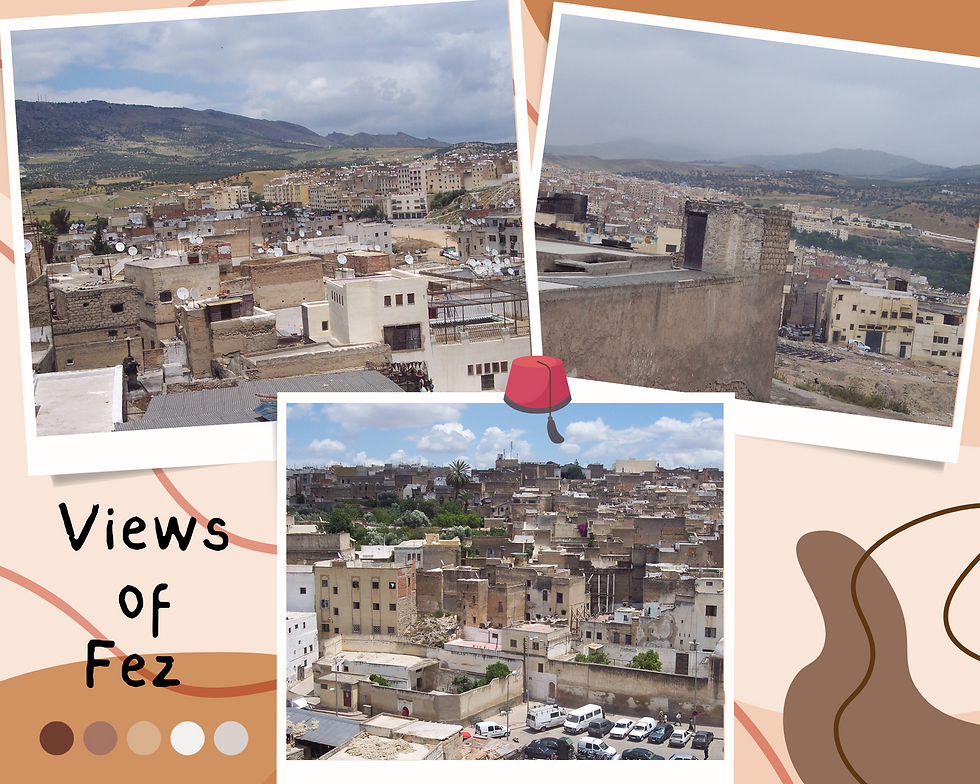
The city is feast for your senses but I admit I found it a little overwhelming. Fez left a very strong impression on me, not just from the odours of the tannery, but for all its ancient beauty and for the Medina, the oldest continually inhabited walled city in the Arab world. It has a completely different vibe to Rabat - all blue and white - as Fez is earthen-coloured and clearly a very old city.
The Medina was designated as a UNESCO World Heritage Site in 1981. It is enormously complex, a rabbit-warren of tiny streets with a maze-like quality. At that point in my travel adventures it was the most terrifying, stimulating, and unique experience I had ever had. I held onto B for a lot of the time as I was dead scared of getting lost and never finding my way back.

The Medina is a fascinating place, a mix of local shoppers, donkeys moving merchandise around, and merchants in constant sell mode. There are colourful characters everywhere, like this water seller.
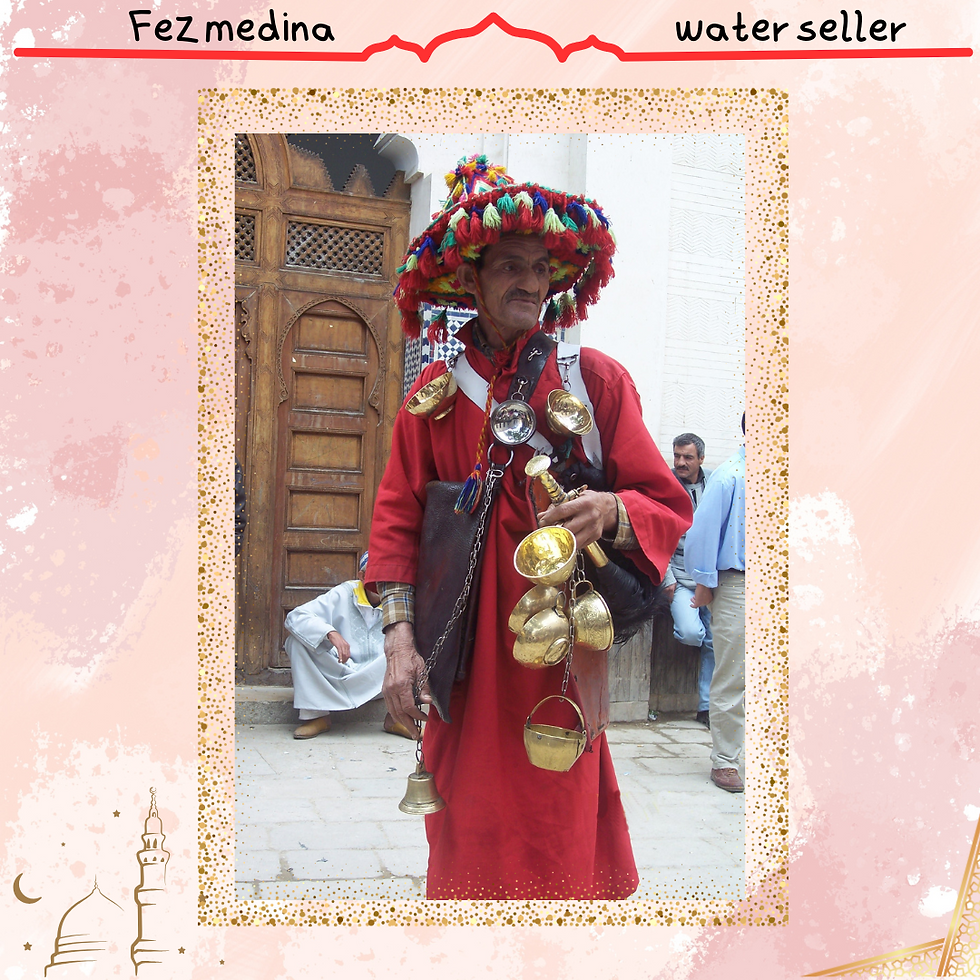
I just can't imagine doing my daily shopping in a place like this. For a start, the sellers are quite aggressive. They follow you around the streets and are quite persistent. It's a hard way to shop and nothing like what we are used to in Australia.
Near the medina is the Chouara tannery, one of three tanneries in the city. It was interesting to watch the people at work and to note the traditional, labour-intensive methods. The smell was quite overpowering, though!
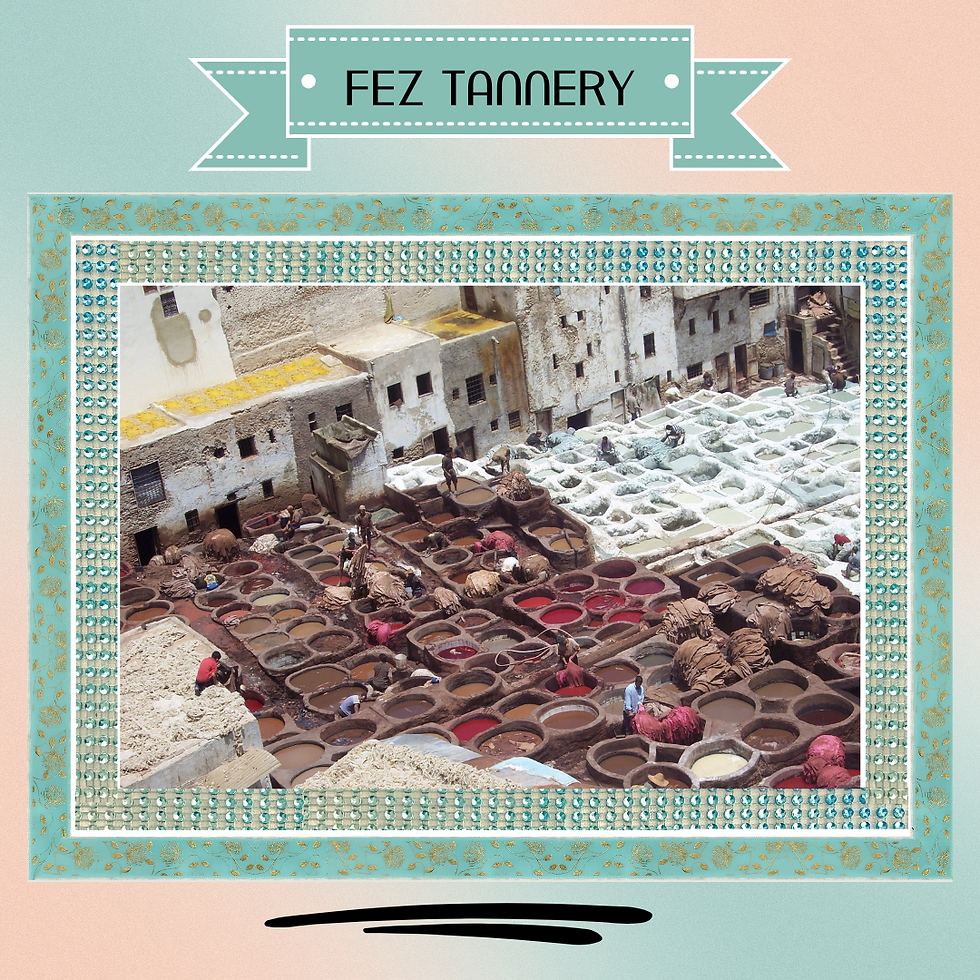
I can't recall now where I bought the leather bag. I am placing the photo here as I could have bought it at the tannery. I know I bought the pashmina at the markets in Marrakech, but I've added the photo here. So much shopping with my shopaholic travelling companion!

We saw more traditional methods of production at the pottery collective we visited in Fez, where the government employs local craftspeople. We were lucky enough to be able to watch the craftspeople during various stages of pottery-making.

We were able to purchase some items from the most incredible shop I think I have ever seen.The shop was full of the items made at the collective. I could have spent hours looking at all the beautiful things.

We bought quite a few pieces between us, including B's purchase of a giant tagine. Being a hardcore shopper, B had come prepared with bubble wrap, so everything made its way safely back home. Good tip!

We'd swung by the royal palace in the morning (built in 1276). You may remember that we visited the royal palace in Rabat. I learned that there is a palace in each of the major cities in Morocco, so the king has somewhere to be no matter where he is. At the time of visit, entry wasn't possible. but we still marvelled at the gorgeous gates and mosaics.

In the evening, we did the optional dinner activity of dinner, music and bellydancing at a traditional restaurant. I know it looks pretty touristy - and it was - but it was a lot of fun nonetheless.
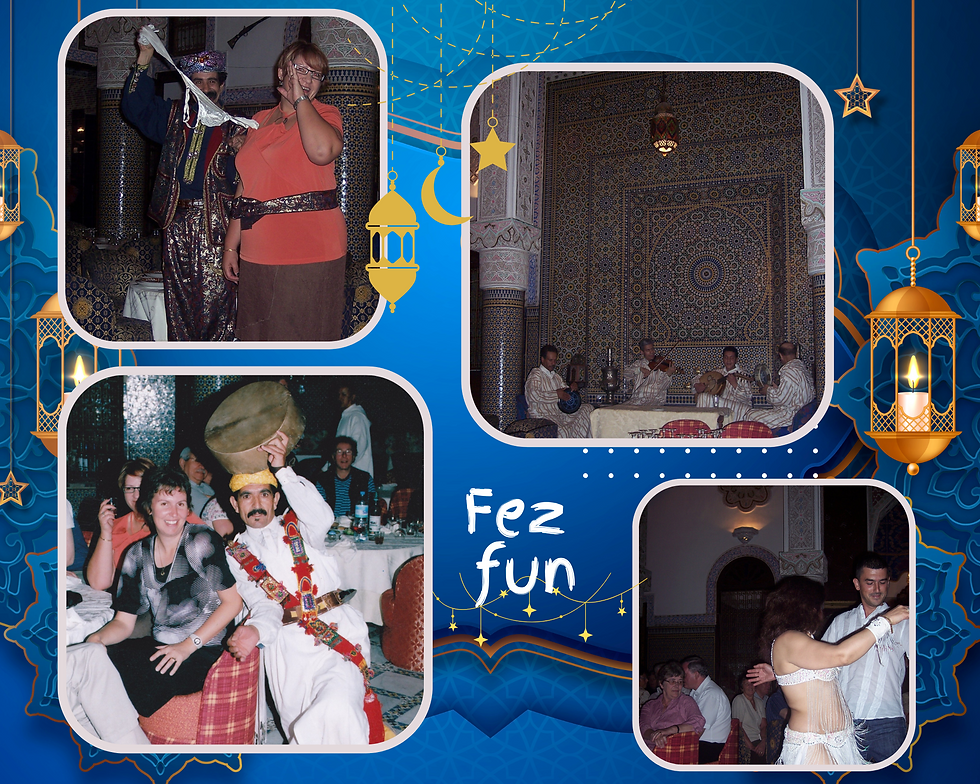
Fez was an incredible experience and one I will never forget. I was confronted by new places, spaces and smells that took me completely out of my comfort zone. I was in love with Morocco, though, after only two days in that incredible country.
Part 3: Mountains, gorges and a desert oasis🏝️
After leaving Fez, we headed to the Middle Atlas mountains, ending our day in Erfoud on the edge of the Sahara. This was our longest travelling day, covering some 430km.
Our first stop was Ifrane, a French-built alpine mountain resort. The town rests at an elevation of 1665m. Morocco has retained a lot of the French influences from when the country was a protectorate. There are lots of French-inspired cafes where pastries and other French food can be bought.
That is us below, in front of the Stone Lion, on a patch of grass near the Hotel Chamonix, in the below photo set. Apparently, the lion was carved by a German soldier during WW2 when Ifrane was used as a prisoner-of-war camp, in exchange for his freedom. The statue is designed to commemorate the last wild Atlas lion, shot near the town in the 1920s. That is the local story, anyway.

It snows in the mountains in winter and I bet it's beautiful in Ifrane then. Ifrane feels like a French or Swiss alpine village but for the clues you are in Morocco, like street signs in Arabic. The mixture of French and Arabic influences is beautiful.
It was such an interesting day in terms of experiencing changing landscapes. We'd left the ancient city of Fez first thing, with its distinctly brown buildings, and then ascended into an alpine village that led us to cedar forests.
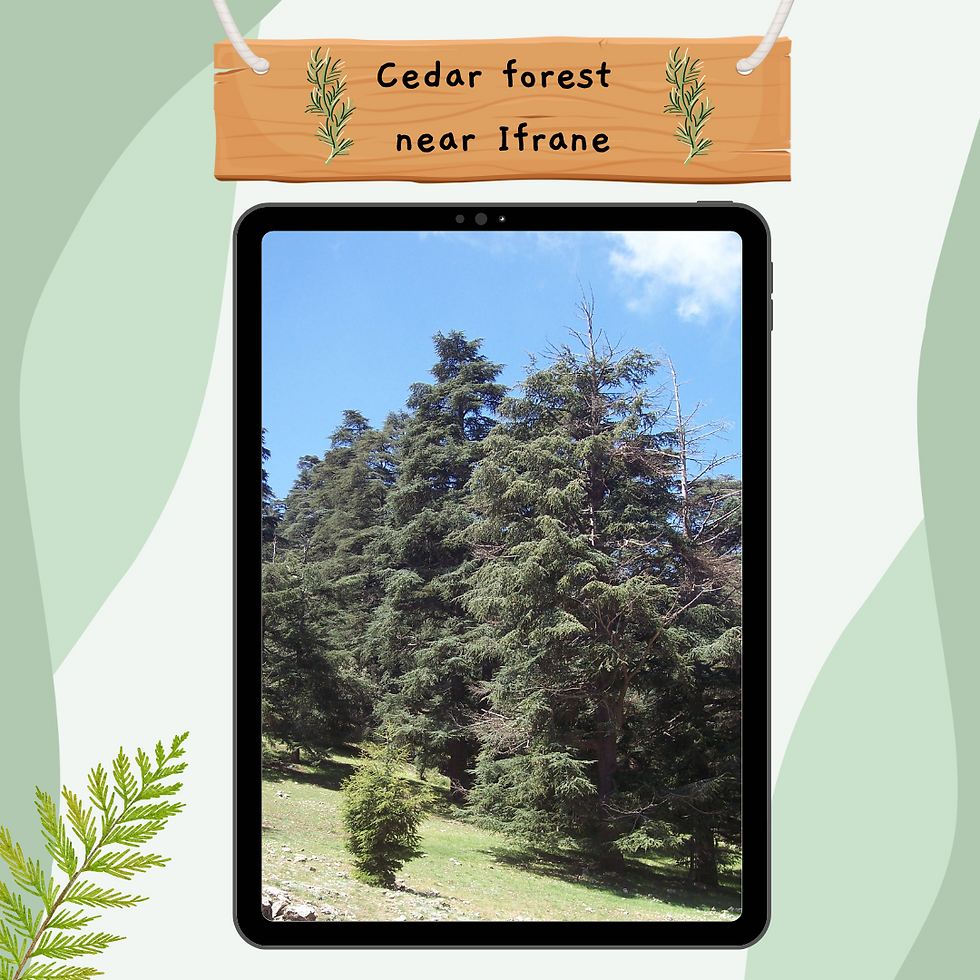
After travelling further into the mountains, the landscape changed quite dramatically, to reveal plains, tiny rocky villages, and the majestic Atlas Mountains.

After lunch at Midelt (shown above), we encountered yet another different landscape, travelling through a tunnel through the Ziz Gorge before reaching the oasis in the Ziz Valley.
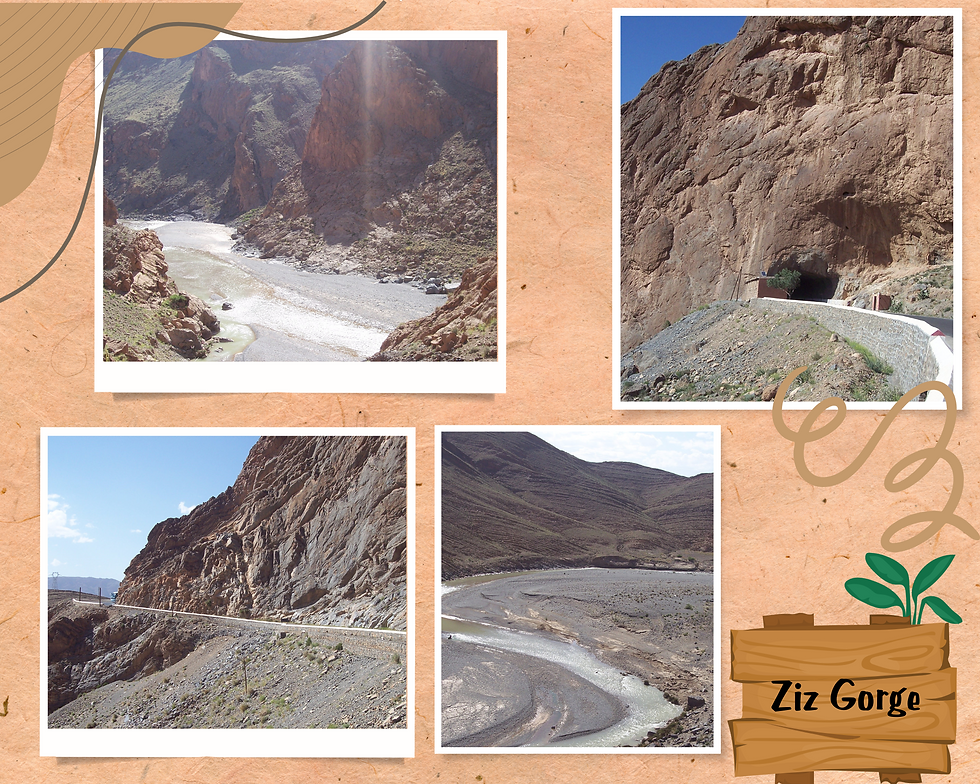
We went to an actual oasis. How cool is that! I couldn't believe it when we arrived there. I knew I was seeing something incredible "in the flesh".

We stopped for an afternoon break on the outskirts of nearby Errachidia at this gorgeous hotel. It was a lovely opportunity to stretch our legs and wander around the pretty hotel - a modern structure built to be faithful to ancient designs.
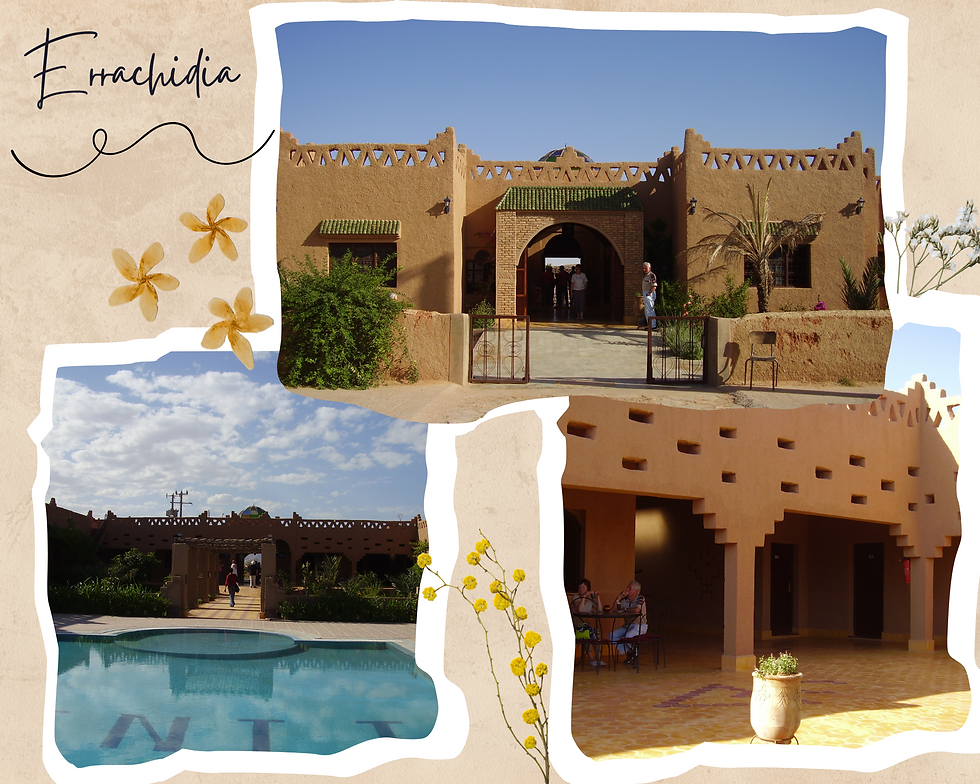
It certainly was a long day so our arrival at Erfoud was welcomed, especially when we saw the incredible hotel we'd be staying in for two nights. This is the Kasbah Tizimi, one of the nicest hotels of the tour. It's a modern hotel but built in a traditional style.
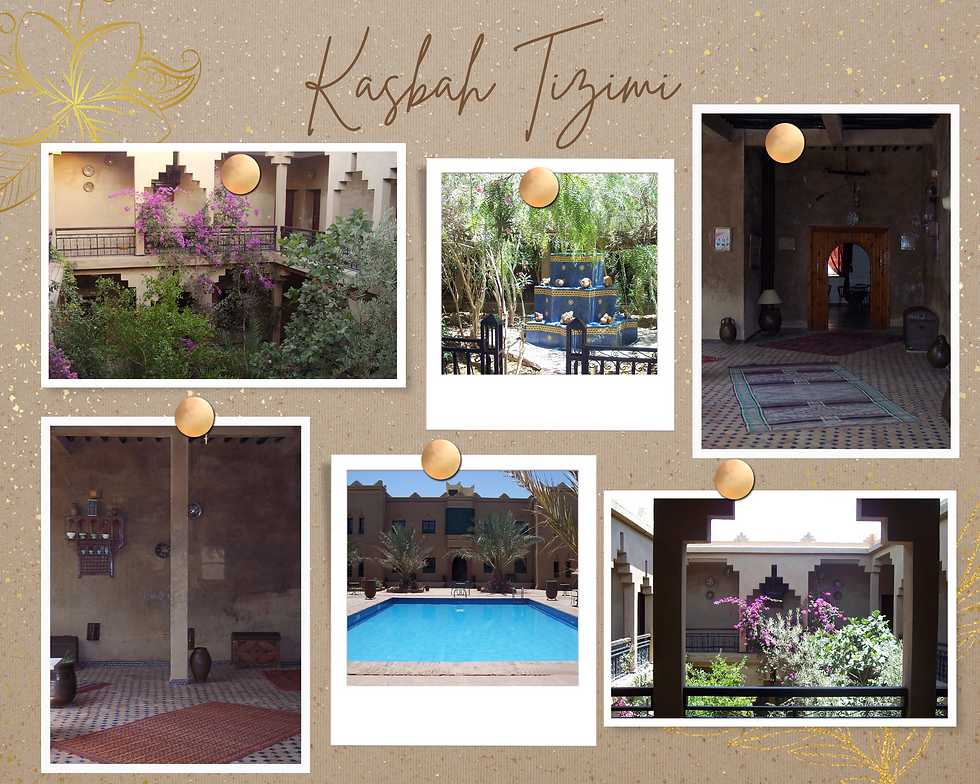
The main takeaway from today's journey: the diversity of the Moroccan landscape. Fez, Ifrane, the mountain plains, the Ziz oasis, and the arid Erfoud on the edge of the Sahara made for a stimulating day. I couldn't contain my excitement at the thought of our Sahara experience the next day!

Part 4: Sahara sunset🐪
We visited the town of Rissani in the morning, a short drive from Erfoud, as a prelude to the main event of the day. I was surprised and intrigued to learn that fossils have been found in the Sahara. The place we visited first is a small factory that incorporates fossilised pieces into the tables and other bits of furniture and home interior items that they create. Really unique pieces! (See photo bottom right below.)
I bought a fossil-turned-into-a-book at the inevitable shop at the fossil factory. It's super heavy and you could probably use it as a doorstop. I just thought it was kind of cool.

The most notable place to visit in Rissani is the Mausoleum of Moulay Ali Sharif, the first ruler of the Alaouite dynasty. We had the chance to sample traditional mint tea there in addition to wandering around the mosque. I'm not a tea drinker but of course I tried some to take part in the ceremony, an interesting process and clearly an important Moroccan custom.

We visited the local markets on our way back to Erfoud. I found that rather disturbing, to be honest. Seeing donkeys tied up in the 'donkey park' with little food and water in the hot sun was sad. I realise that donkeys are working animals in Morocco but they didn't look very healthy to me.

After having lunch in the hotel and resting for a bit (and trying to remove the donkey images from my brain), we headed out into Erg Chebbi, one of Morocco's several large seas of dunes (ergs) formed by wind-blown sand, about 60km from Erfoud. Technically Erg Chebbi lies on the edge of the Sahara, but the Sahara nonetheless!
The first bit of our journey was spent in land-rovers with local guides. The landscape is kind of arid, flat, and rocky and not what I was expecting. We stopped mid-way to meet a Berber family. Graham obviously knew this family well and he conducted the visit with due respect, but I couldn't shake the feeling we were being rather intrusive, standing there staring at these people. This was their home, not a tourist attraction. It was still interesting to learn about their way of life and see what a Berber settlement in the middle of nowhere looked like. It just felt a bit exploitative and I wasn't entirely comfortable with it.
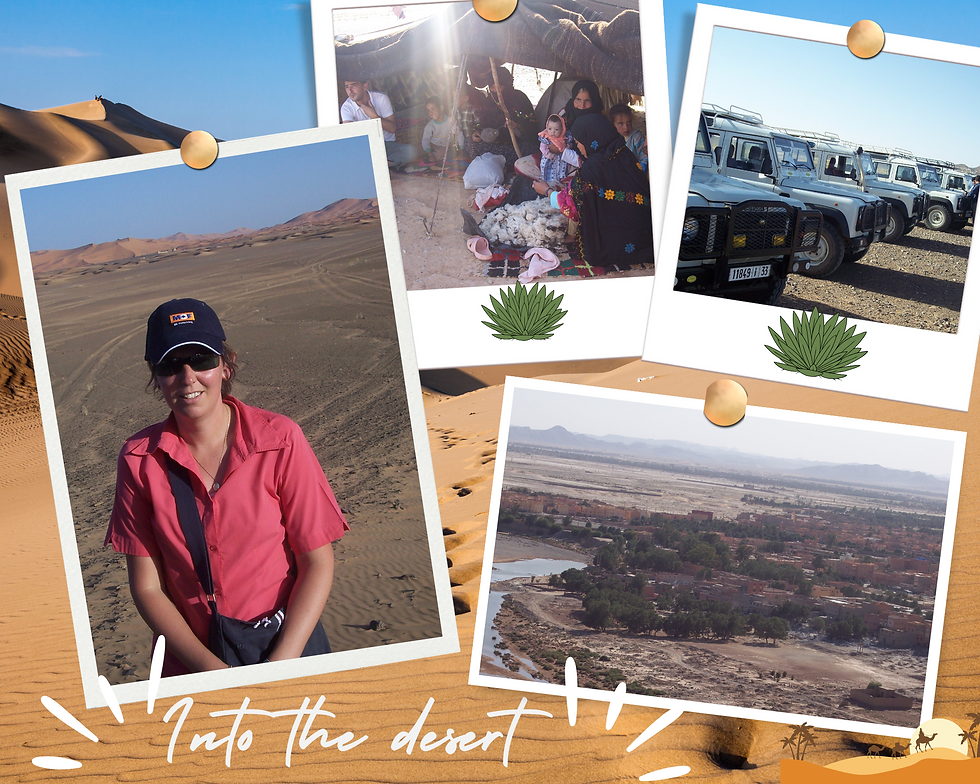
We first came upon a kind of desert outpost, where we were assigned camels and a guide. Our guide was a lovely man who enjoyed talking to us and showing us the beauty of his homeland. He proudly told us he'd worked on the set of the first Mummy film that had been shot in the region. Awesome.
Inexplicably, my camel was named Jimmy. Getting onto Jimmy's back and then being flung around as he stood up is an experience I will never forget. Camels tip themselves forward and then back before they go up. I totally felt as if I was going to fall off before we'd even got going! Kind of terrifying, actually.
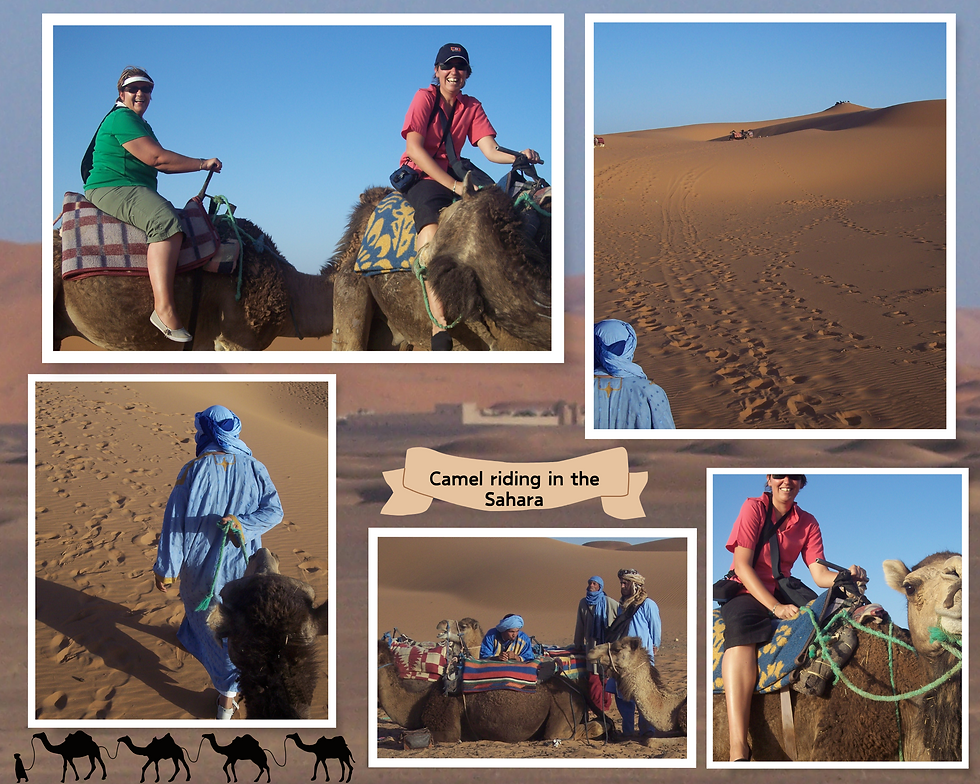
I am laughing in the photo above as you can see Jimmy licking my leg. His tongue was rough and a bit salty. Camel tongue-licking was nothing, mind you, compared to developing 'camel butt'. Sitting on one of those suckers for a couple of hours totally gave me a sort butt for days!
Several days of camel butt was totally worth it for scenes like these, though. Isn't this just the most spectacular thing ever? I still cannot believe, all these years later, that I have been into the Sahara Desert.

This is my favourite shot: The photo shows the shadows that we made as we walked along the sand. That's me, on the first camel, following our guide.
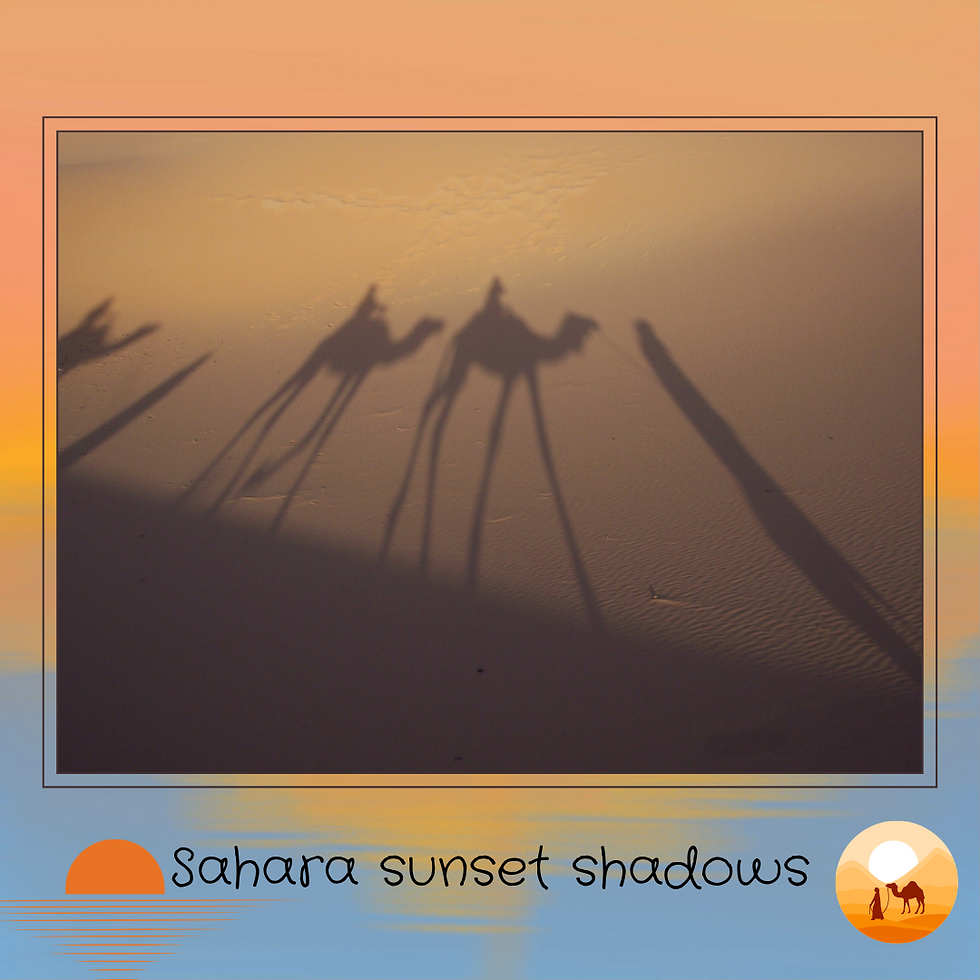
And, yes, it was definitely a bucket list experience.
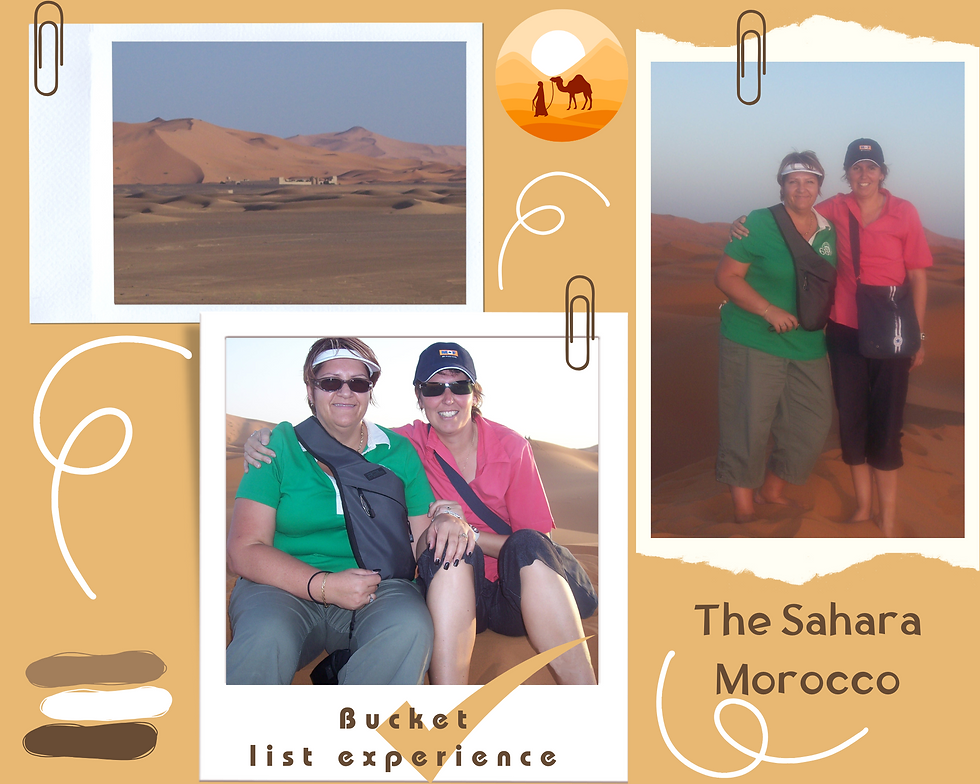
It was really late by the time we got back to the hotel, as we rode on the camels for about an hour into the desert, wandered around for a bit on the dunes, and sat on a dune to experience the incredible sunset, then headed back to the outpost for dinner before driving back in the land-rovers to Erfoud. But what a day it was!
Part 5: More mountains and gorges and a famous kasbah ⛰️
We left Erfoud on the fifth day of our tour and drove along the eastern slopes of the High Atlas Mountains, stopping for a break to wander through a local village. We were then treated to the beautiful Tinerhir oasis, some 30 kilometres of palm trees irrigated by a network of pipes and canals.
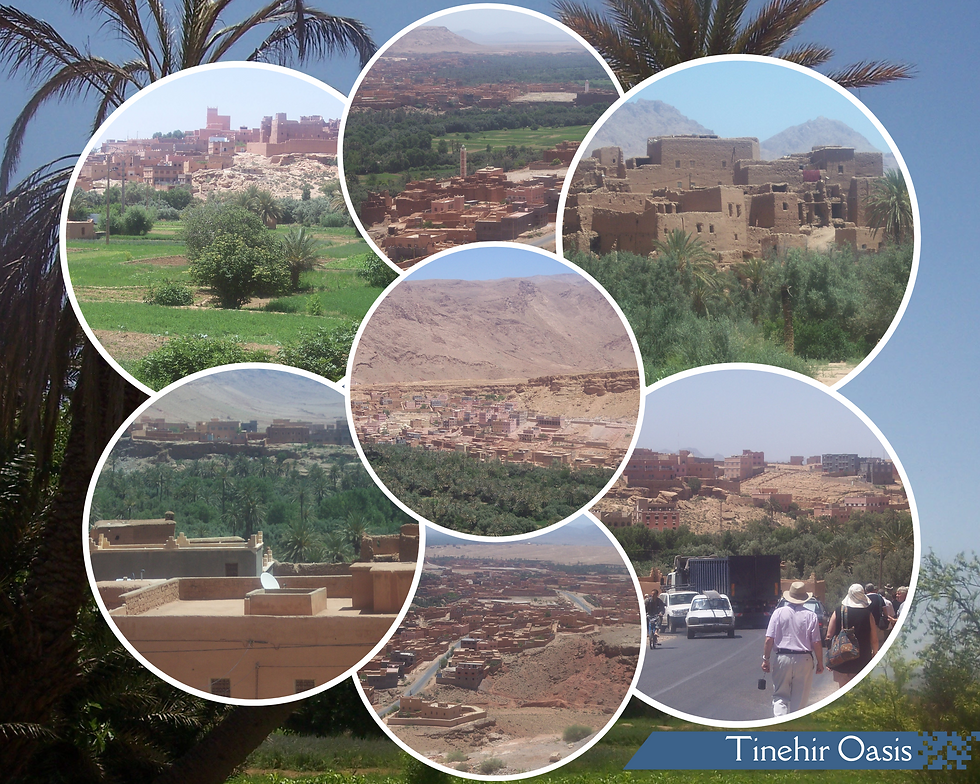
The highlight of our day for me was experiencing the majestic Todra Gorge. Both the Todra and Dades rivers have carved out cliff-sided canyons in their final 40km stretch through the Atlas Mountains, leaving behind a series of reliefs and etches in the rocks. Todra is the name of the last 600m of the canyon. The river has since dried up, leaving it to your imagination to picture the power of nature to carve out the landscape. The canyons aren't wide (often as little as 10m), but they rise up to 400m in some places. The canyon floor is mostly dry, with only small streams of water, as you can see in my photos.

Fun fact ℹ️ The Todra gorge has made an appearance in several films, including The mummy returns, in the 'water wall' scene when Imhotep uses his powers to control a huge wall of water. Cool. |
At the end of our 350km journey was the city of Ouarzazate (pronounced war-za-zat). The city, nicknamed "the door of the desert", sits at an elevation of 1160m, in the middle of a plateau south of the High Atlas Mountains. It is Morocco's film capital, where Atlas Studios is located. Loads of films have been shot in Ouarzazate, including Gladiator, The living daylights, The mummy, season 3 of Games of thrones, and season 5 of Prison break. Ouarzazate was the most 'modern' of the cities we visited, kind of a sanitised version of the traditional, older cities in Morocco. We even stayed in an Ibis, albeit one built to look like a traditional Moroccan building. The hotel was in better condition than some of the others we'd stayed in, but I think I preferred the others on the tour as they felt more authentic. That's the Ibis, in the below circle collection in the circle.

B and I had a wander around the town square just as the sun was setting. It was pretty square and I just loved the street lamps. I bought a rug in a shop just off the square, with Berber symbols woven into the design. That's it in the above photo, still hanging on my wall.
Our brief stay in the city included a visit to the Taourirt kasbah, the former el Glaoui palace, the only real historical site of interest in Ouarzazate. It was built in the 19th century and reached the height of its importance during the 1930s when the el Glaoui powers were at their peak.

Close to Ouarzazate in the foothills of the southern slopes of the High Atlas Mountains is Ait Benhaddou, a famous ksar (fortified village). We visited the ksar the next morning, day six of our tour. A ksar is a group of earthen buildings surrounded by high walls. Ait Benhaddou is considered to be one of the most stunning examples of Moroccan earthen clay architecture. The ksar's structures are made entirely out of rammed earth, clay bricks, and wood. You may recognise the ksar from Gladiator.
I remember standing across from the ksar, barely able to believe I was there. Such a stunning piece of architecture and nothing like I'd ever seen before.

Ait Benhaddou has been a UNESCO World Heritage site since 1987. The site of the ksar has been fortified since the 11th century although none of the current buildings is believed to be older than the 17th. The ksar sits along the former caravan route between the Sahara and Marrakech and once had great strategic importance along this trade route.

Leaving the ksar, we drove towards Tichka Pass, a 2260m elevation in the heart of the High Atlas Mountains. The pass connects Ouarzazate with Marrakech. It's the highest paved mountain pass in North Africa. The landscape is absolutely breathtaking, with winding roads and stunning mountains. The panoramic views from places we stopped for photos were just stunning.
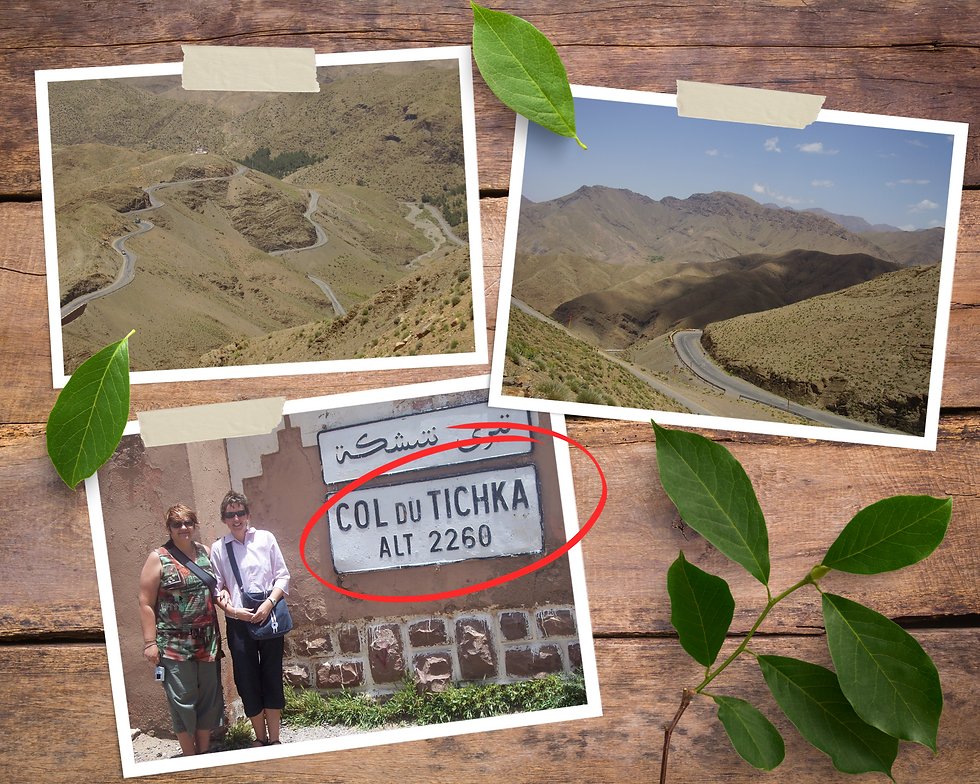
Our day ended in Marrakech, but not until we'd experienced the myriad of landscapes in the High Atlas Mountains. As you get closer to Marrakech, the landscape changes to a tapestry of red ochre.

Stretching our legs after an afternoon in the bus, B and I wandered around the famous Jemaa El Fna Square and marketplace in Marrakech. This was just a taster, as we returned with the group the next day. Marrakech is one of the most popular tourist destinations in Morocco and it was much busier than the places we'd just been to in the mountains. The evening stroll around the square was lovely, though, despite the crowds.
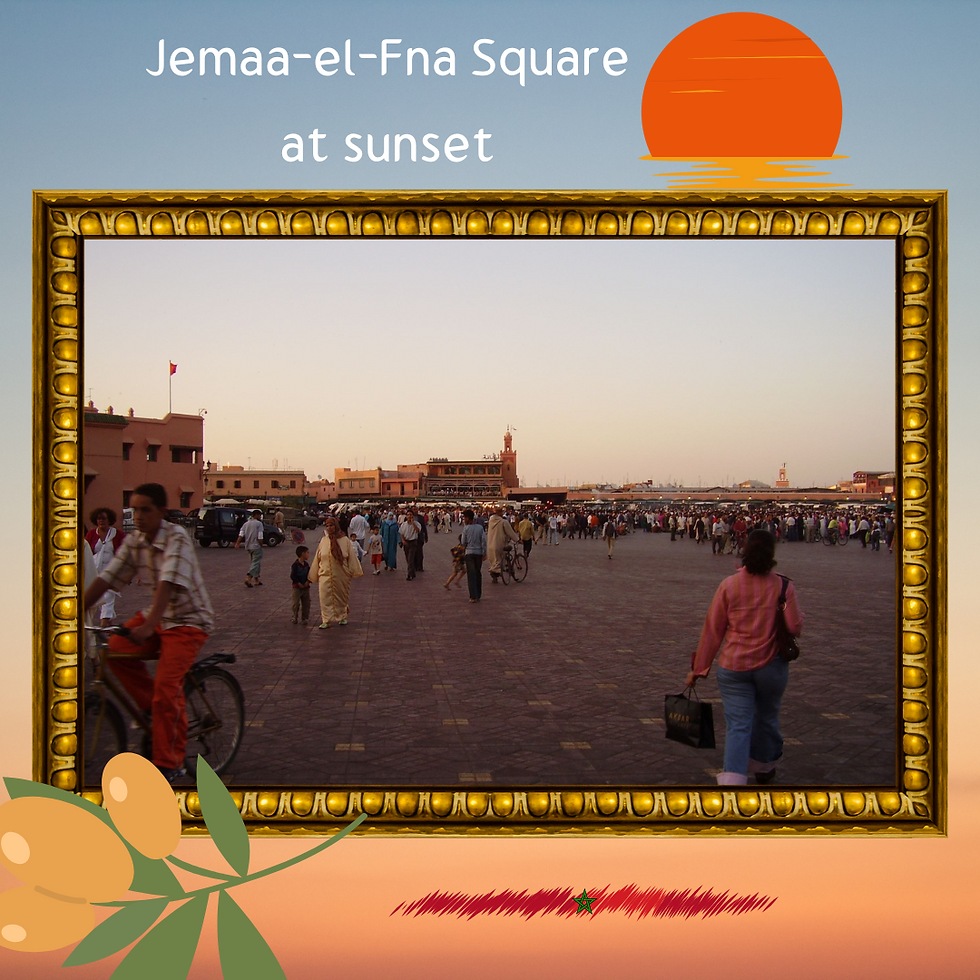
Part 6: Magnificent Marrakech🧡
Marrakech was founded in 1070 and is now the fourth largest city in Morocco. It is considered to be one of the great citadels of the Muslim world. The main landmarks that we had the chance to visit were the Jemaa-el-Fna Square and the souks of the largest traditional market in Morocco, the Koutoubia mosque, and Bahia Palace. We also saw the city ramparts that stretch for 19km around the medina of the city (built in the 12th century).
Here's the square, complete with snake charmer. It's a UNESCO World Heritage site (since 1985). We were there in the morning so it wasn't too busy. The markets are a complex network of souks where the usual hard sell and bartering goes on, although not as confronting, chaotic or difficult to navigate as the Fez medina.
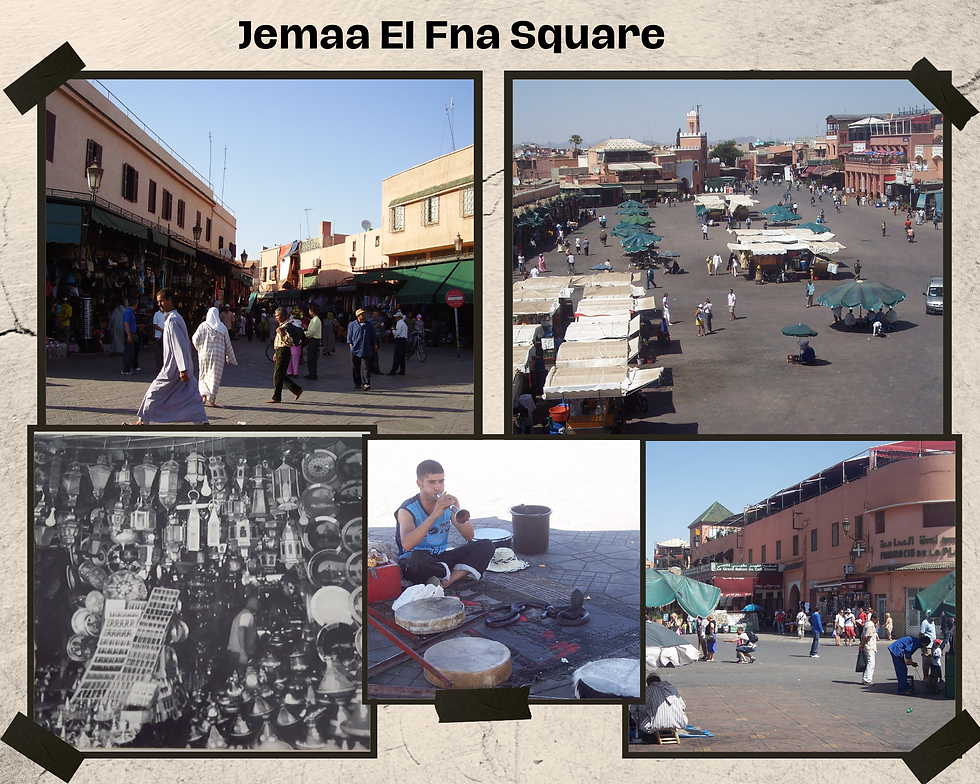
Here's the famous Koutoubia mosque, the largest mosque in the city, completed under the reign of al-Mansur (1184-1199). It's made of red stone and brick and measures 80m long and 60m wide. The sandstone minaret stands 77m high. Nearby is the pretty Jardin Majorelle.
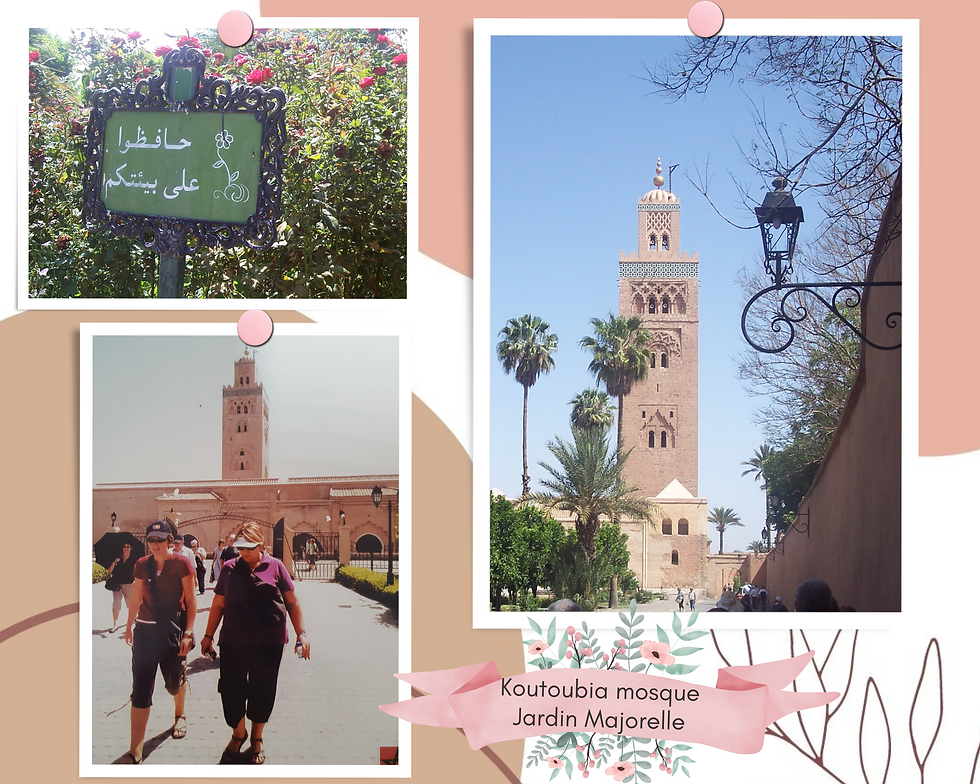
We also visited the gorgeous Bahia Palace. It was built in the late 19th century by Bou-Ahmed, at the time the Grand Vizier of Marrakech. He lived there with four wives, 24 concubines, and a bunch of children. The palace took seven years to build, with hundreds of craftspeople brought from Fez to work on its wood, carved stucco, and mosaics.

The city ramparts were way cool especially for the views of the city and insights into Moroccan life, including dodgy wiring. We visited a traditional herbalist in the afternoon and I let myself be talked into buying a bunch of stuff. Travelling with a fervent shopper is hard on the budget!

Marrakech is a busy, crazy place and what I expected Morocco to be like. We had a wonderful time exploring the city, but I preferred the mountains and the rural landscapes.

Later that day, we went out with the group for a traditional dinner, with more snake charmers and belly dancing. Not really my thing to do such touristy stuff but you've got to eat, right?
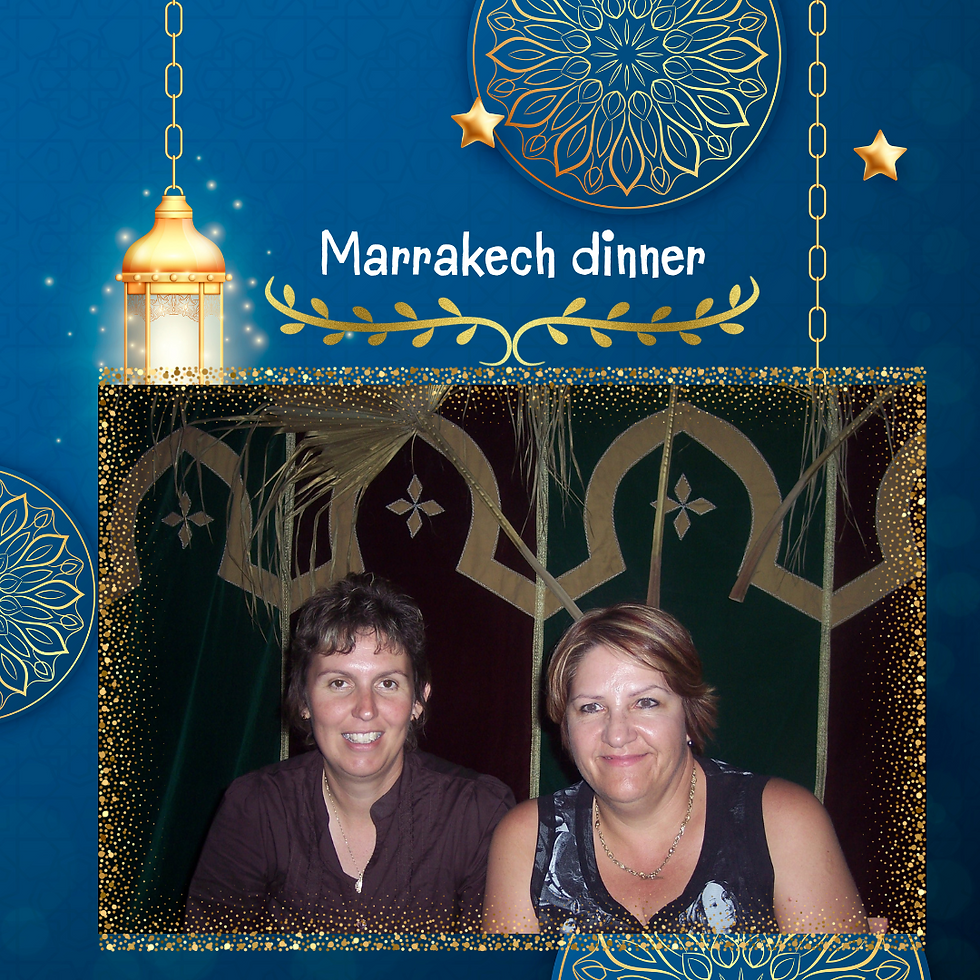
We stayed in a lovely hotel in Marrakech and even had some time on our last afternoon in the city to check out the pool.
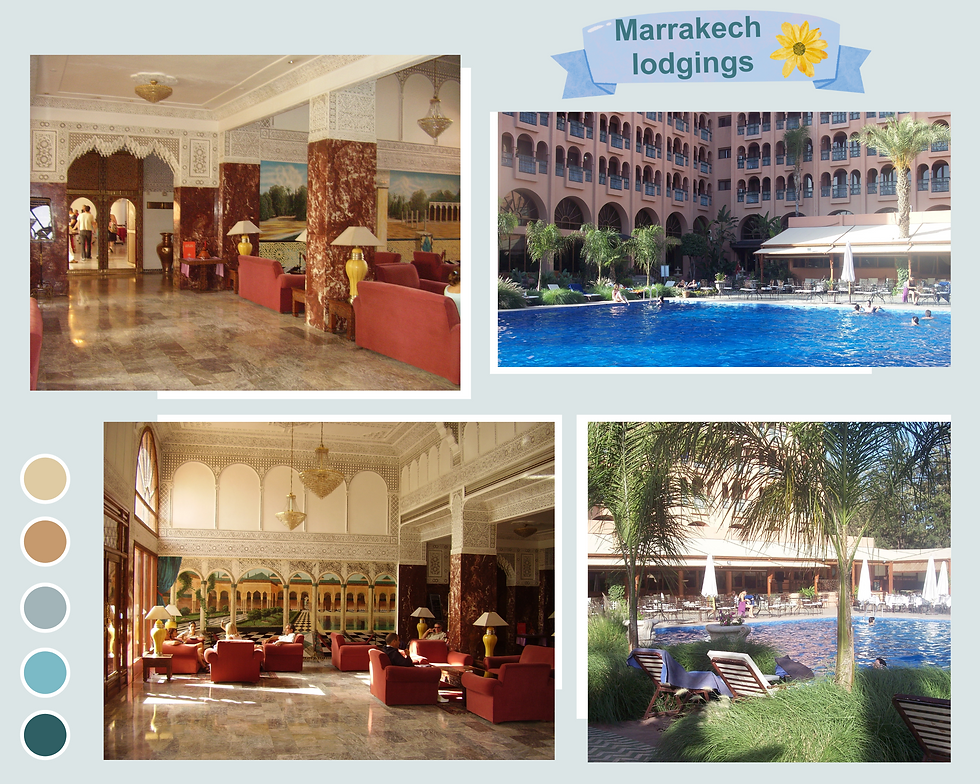
Part 7: The end of the road at Casablanca🕌
We ended our Moroccan odyssey where we had started: in Casablanca. Arriving mid-morning from Marrakech the next day, we spent the rest of the day with a gorgeous guide (who wore pink and white traditional clothing). You can see our guide in the donut shot below.
Below is the beautiful waterfront of the city, with Hassan II mosque in the far distance. It's hard to believe this is Africa as it looks like a European beachfront.

We stopped along the boardwalk for fresh donuts. Yum. I'm not sure why I didn't take a photo of the donuts we ate, but I found one here that gives you an idea of what they look like (inset photo below).

Then we had the absolute pleasure of visiting the mosque. The Hassan II mosque (completed in 1993) is the second largest mosque in Africa and the seventh largest in the world. The minaret reaches 210m, the world's second tallest, and is topped by a laser, the light from which is directed towards Mecca. The building is impressive in itself, but the location even more so. It stands on a promontory looking out to the Atlantic Ocean. It's also huge: a maximum of 105 000 worshippers can gather for prayer - 25 000 inside the mosque hall and another 80 000 on its grounds. Tres magnifique!

Below you can see B and me standing in front of the main tile fountain in front of the mosque. The turquoise and ivory zellige (mosaics) are stunning! I can't even imagine the hours of work it would have taken to complete the design, with its geometric pattern and perfect symmetry.

We only had a few hours to get something of a feel for the city before dinner and the end of the tour. Casablanca is a mix of architectural styles, including traditional Moroccan, art nouveau and art deco. It is the largest city in Morocco and its chief port and economic and business centre.
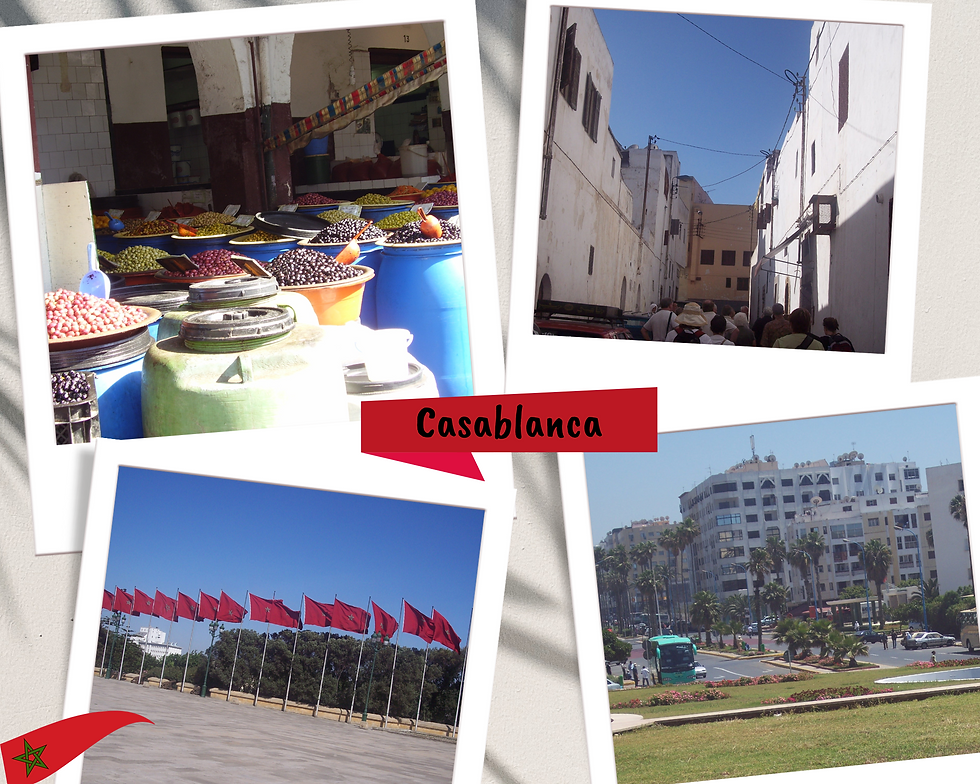
I loved Casablanca, more so than Marrakech, I think because of its position on the Atlantic Ocean, the Hassan II mosque, and the gorgeous waterfront.
We had dinner in the hotel that evening with the group before we all departed for our respective home countries the next day. In our case, we headed to Dubai. See my post on Dubai for my impressions of that part of our trip.
I was quite sad to leave the next day, as I had fallen in love with the country. In all honesty though, as an introvert, it was a relief to be off the tour. I was looking forward to our Dubai stopover and a few days to regroup before heading back home.

Morocco is a nice way to experience North Africa without going too hardcore. It's a good place to go if you are visiting an Islamic country for the first time (as I was). The food is delicious. There are lots of oranges, figs, and dates, omelettes, couscous, and tagine. The French influence is still prominent and there are cafes everywhere, serving croissants and other pastries, and of course, mint tea! The food flavours are a mix of spices such as cumin and turmeric. Tagine-cooked food (in a red clay pot, essentially) is worth visiting the country for alone. Nothing seems to be kept all that cold, though, and I ate a ton of yoghurt that had clearly been sitting out for a while. Amazingly, I didn't get sick!
Shopping is a unique experience, for the things you can buy and the bartering system. Bargaining is tough, however, and sellers will chase people down a laneway to get a sale. That can be quite overwhelming. I kind of missed being able to wander around a shop hassle-free and look at things. There's a bunch of stuff you can buy all over Morocco, from pottery, to lead lighting, fossils-inspired crafts, tassels, jewellery, and leather goods, to herbal remedies.
Travelling around the country gives you an insight into the complex web of cultures and identities in Morocco, where Arabic and Berber are the official languages and French is widely spoken, and Islam is the predominant religion.
At the time of our trip, women dressed conservatively, but ranged from wearing jeans with traditional clothing on top (usually younger women), to complete coverage. We found the people to be friendly and welcoming and I loved wandering around the cities, towns, and mountain villages and imagining what life must be like. Yes, you get stared at a bit, as a Western woman, but I didn't feel unsafe at any time (except in the Fez medina, and that was more to do with my fear of getting lost!).
One of the best reasons to travel to Morocco is its varied landscapes. We saw the blue and white buildings of Rabat and the stunning blue of the Atlantic Ocean, the ancient city of Fez, desert sand dunes, mountains, villages made from mud and straw, and a French alpine village. Casablanca, Marrakech and Rabat are quite distinct cities geographically and architecturally, each with their own points of interest. Moroccan architecture itself is beautiful and intriguing. You can find intricate mosaic tiling wherever you go, along with Berber, Arab and European influences on building design. And of course, the beautiful Sahara Desert.

Morocco itself: A beautiful and complex country with warm and friendly people. It is also loud and chaotic!
A feast for your senses: Colours, sounds and smells all vied for my attention. Tagine-style food: yum!
What I saw around me: The diverse, stunning landscapes and architecture completely captivated me.
The tour: Lots of laughs with our tour buddies, a knowledgeable and fascinating guide, and a bunch of people who complained about pretty much everything. Why were they even there?
It goes without saying that riding a camel into the Sahara Desert and watching the sun set over the dunes will always be a vivid and lasting memory.
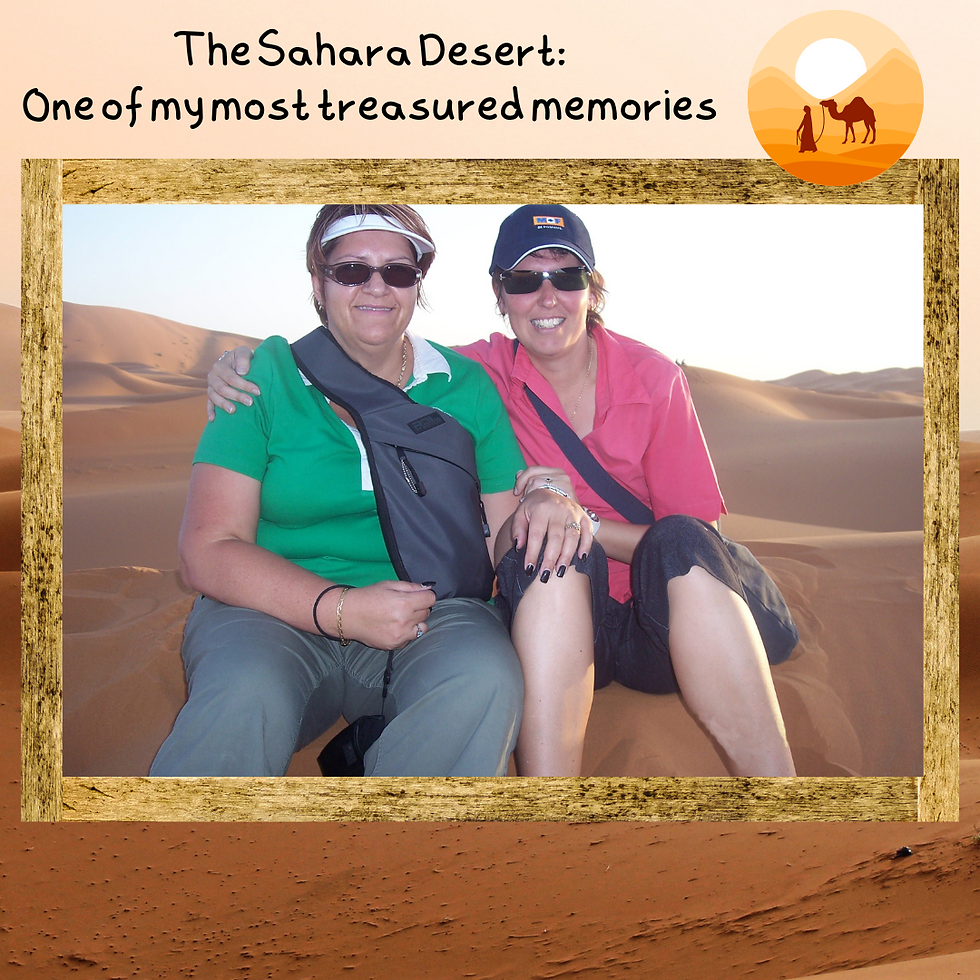

The girls-only trip reignited my wanderlust after a lengthy travel hiatus due to having young children and working part time.
It was my first time away from my children alone and the first time as a mother I felt like I was my own person again.
Morocco was also my first experience of an Arabic and Islamic country. I fell in love with the architecture and the beautiful mosaics.
I learnt to embrace and appreciate the beauty in the diversity of our giant planet. I also realised just how high the standard of living is that I am privileged to experience in Australia.
The trip saw the beginning of my love affair with old doors. I've been photographing them on trips ever since. I have the below photo in a frame in my home office. I was so keen to see what lay behind this one in the Rabat kasbah!

There is something unique and very special about Morocco. I am so glad I was able to experience its beauty. The country has my heart and I would love to return one day.






Comments